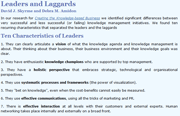A Knowledge-Enriching Culture
An inhibiting organizational culture has often been highlighted as one of the major obstacles to delivering KM successfully. Anyone who has ever been involved with a KM project has heard of the 'knowledge is power' syndrome. Those who have it, do not want to relinquish it too easily since it makes them feel expendible.
On this page we answer the questions "What is a knowledge-enriching culture?" (i.e. one that supports knowledge development and sharing) and "How can we change our culture to be like that?"
Characteristics of a Knowledge-Enriching Culture
There are probably more definitions of organization culture than there are of knowledge management! One of the simplest and most straightforward is "the way we do things around here". It involves artefacts, rituals, values, attitudes and behaviours, yet is largely invisible. A culture that enhances the use of knowledge is often described as creative, innovative and open. Typically it will exhibit these characteristics:
- Individuals are empowered
- Active learning is encouraged - from customers, from the results of an individual's own actions
- There is a continual quest for improvement and innovation
- Communication is intense, lateral and open; managers are not protective of hoarding information
- Networking - individuals spend as much time interacting with those outside their team as those within it
- Experimentation is encouraged; if procedures and rules don't make sense they are not followed verbatim
- Goals and performance measures are aligned from top to bottom - across departments, teams and individuals
- Expertise is valued and those with it are encouraged to develop it and share it
- Time is taken to experiment, reflect and learn.
Levers of Culture Change
Many organizations have gone through culture change to adapt to their competitive business environments. There is no single panacea, but rather a set of approaches used in combination. Here are some of the levers:
- Current culture assessment - rather like a knowledge audit, a good starting point is to understand your current culture and how it varies in different parts of the organaization
- Changing reporting lines and organizational structures - it often helps to signal the importance of knowledge activities within an organization
- Practicing what you preach - it's all well and good for a senior manager to stress the importance of sharing, but it is something they have to do themselves
- Introducing a performance measurement and management system that takes account of the value of knowledge
- Redesigning the office - providing more open spaces, meeting areas (even informal ones near coffee machines) and project rooms
- Implementing social networking - Wikis, blogs and discussion forums are all examples of 'grass roots' knowledge sharing
- Introducing various KM techniques that bring people together to share information - storytelling, After Action Reviews, sharefairs and communities of practice are but a few
- Reward and recognition for good KM practice and knowledge sharing.
A good human resources department is one that can play a key part in orchestrating culture change. But as with other aspects of knowledge management, it requires leadership from the top and throughout the organization in the form of role models, to ensure that the correct behaviours are reinforced.
Last updated: 19th March 2011


